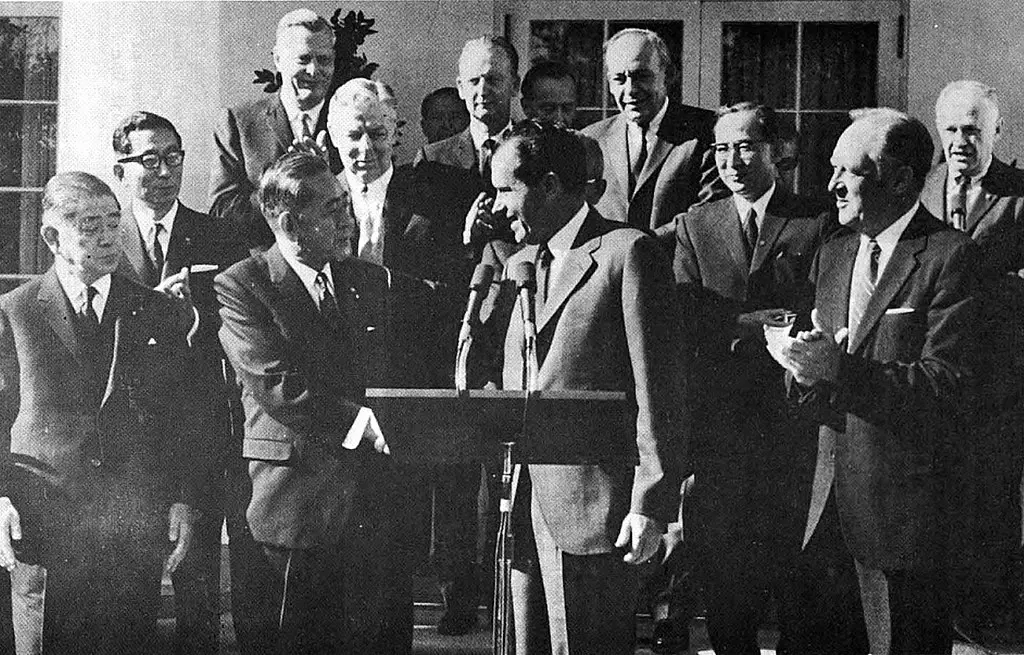Ping Pong Diplomacy refers to the exchange of table tennis players between the United States and China in the early 1970s. This event marked a thaw in Sino-American relations and paved the way for a diplomatic breakthrough.
Ping Pong Diplomacy erupted onto the global stage at a time of intense Cold War tensions. In 1971, amidst a milieu of political estrangement, an unexpected invitation from China to the American table tennis team emerged.
The event garnered worldwide attention as athletes became inadvertent ambassadors, bridging a chasm that had yawned wide for over two decades.
As the U. S. Team stepped onto Chinese soil, they set the scene for a remarkable narrative of sports transcending diplomatic stalemate.
This pivotal exchange culminated in President Richard Nixon’s historic visit to China in 1972, leading to the re-establishment of diplomatic relations between the two countries.
Ping Pong Diplomacy thus exemplifies the power of sports in fostering international dialogue and easing geopolitical tensions.
The Origins Of Ping Pong Diplomacy
In the pantheon of diplomatic breakthroughs, few moments are as uniquely captivating as Ping Pong Diplomacy.
It was during the height of the Cold War—a period characterized by intense and often icy relations between the East and the West—that an unexpected twist emerged, with table tennis at its core.
Ping Pong Diplomacy became a metaphor for the subtle art of diplomacy, as it paved the way for thawing relations between two global superpowers: the United States and China.
Brief History Of Ping Pong Diplomacy
The swirling winds of change began in 1971, during the 31st World Table Tennis Championship in Nagoya, Japan. By chance or design, players from the American and Chinese teams interacted, which led to an invitation that altered the course of geopolitical history.
The United States Table Tennis team became the first American group to set foot in China since the Communist party takeover in 1949.
This event wasn’t merely about sports; it was a strategic play that challenged the global status quo and sparked a series of diplomatic engagements.
Sports, as it turned out, could indeed bridge political divides.
Impact Of Ping Pong Diplomacy On International Relations
The matches played between American and Chinese athletes carried weight that extended far beyond the edges of the table tennis table. These athletes, inadvertently or not, laid the groundwork for a dialogue that stretched across ideological divides to lessen the tension between their countries.
The exchange of paddles for diplomacy led to the landmark meeting between President Richard Nixon and Chinese leader Mao Zedong in 1972. This monumental step ushered in a new era of Sino-American relations, fundamentally transforming the geopolitical landscape of the 20th century and beyond.
The term ‘Ping Pong Diplomacy’ now encapsulates the notion that sports can act as a universal language, promoting peace and understanding where traditional diplomacy might stumble.
The Role Of Ping Pong In Diplomatic Relations

Sport has the unique power to bridge divides and bring people together, transcending the complexities of diplomatic discourse. Among the various sports that have played a role in international relations, table tennis, affectionately known as ping pong, holds a distinctive place.
This seemingly innocuous game became a symbol of thawing tensions during a pivotal era in world history, leveraging its universal appeal and the kinship it fosters among players to open the doors of dialogue between estranged nations.
The phenomenon, widely recognized as “Ping Pong Diplomacy,” serves as a profound testament to how sports can facilitate peaceful engagement and foster mutual understanding.
Ping Pong As A Diplomatic Tool
Conventional diplomacy often takes place in grand halls and behind closed doors, but the diplomatic tool of ping pong demonstrates that significant strides in international relations can occur on the humble table tennis court.
During intense periods of political standoffs, ping pong serves as an innocuous entry point for communication, allowing nations to engage without the pressure of achieving immediate high-stakes outcomes.
The sport provides a neutral ground where players and nations can focus on shared interests and commonalities, setting the stage for more profound diplomatic discussions.
- Table tennis matches create opportunities for casual interactions between officials.
- High-profile ping pong tournaments offer platforms for initiating contact.
- The sport acts as a universal language, easing communication barriers.
Key Events And Figures In Ping Pong Diplomacy
The chronicles of ping pong diplomacy are marked by pivotal moments that have shaped the course of international politics.
A prominent example unfolded in the early 1970s when American and Chinese table tennis players exchanged visits, piercing the veil of the Cold War and opening direct communication channels between the two countries.
This groundbreaking move was a crucial step toward the eventual normalization of relations between the United States and the People’s Republic of China.
| Date | Event | Significance |
|---|---|---|
| April 1971 | US Table Tennis team invited to China | First American group to set foot in China in over two decades |
| 1972 | Richard Nixon’s landmark visit to China | Lead to a significant shift in Sino-American relations |
- Zhuang Zedong, a Chinese ping pong player who reached out to his American counterparts.
- Glenn Cowan, an American player who reciprocated the gesture, symbolizing a willingness to connect.
- Henry Kissinger and Richard Nixon, who recognized and seized the opportunity for diplomatic breakthroughs.
These events and individuals exemplify the extraordinary role of sports, specifically ping pong, as a conduit for positive change and as a strategic instrument in the art of diplomacy.
The Significance Of The 1971 World Table Tennis Championships
In a world where sports often transcends far beyond the playfield, the 1971 World Table Tennis Championships in Nagoya, Japan, stand out as a hallmark of such an impact.
More than merely a competition, this event paved the way for a thaw in Sino-American relations, marking its significance not just in the realm of sports, but in the annals of global diplomacy.
This historical moment, often referred to as “Ping Pong Diplomacy,” showcased the profound power of sports as a universal language capable of bridging seemingly insuperable divides.
The Historical Context Surrounding The Championships
The early 1970s were a period rife with tension on the international stage. The Cold War dominated global politics, and the United States and the People’s Republic of China had been in a state of diplomatic isolation for almost two decades.
Against this backdrop, the World Table Tennis Championships took on an unexpected significance.
- Heightened tensions between nuclear powers required innovative approaches to diplomacy and communication.
- China’s Cultural Revolution had led to its isolation from the international community.
- America’s involvement in the Vietnam War created widespread desire for diplomatic solutions.
The Unexpected Turn Of Events That Led To Diplomatic Breakthroughs
In what appeared to be a sequence of serendipitous occurrences, the 1971 World Table Tennis Championships set the stage for a diplomatic volte-face that few could have predicted. These events unfolded as follows:
- An accidental encounter between American player Glenn Cowan and Chinese player Zhuang Zedong, which culminated in an exchange of gifts.
- Zhuang’s gift to Cowan, a silk-screen portrait of the Huangshan mountains, became a symbol of budding friendship.
- This small act led to an invitation from the Chinese team for their American counterparts to visit China.
- An ensuing historic tour of China by the U.S. team was widely covered, heralding a warming of relations.
The Championships unexpectedly transformed into a diplomatic platform, eventually leading to President Nixon’s landmark visit to China in 1972—one of the pivotal occurrences of 20th-century international relations.

Credit: sustainabilityreport.com
The Impact Of Ping Pong Diplomacy On Us-china Relations
The game of ping pong, typically perceived as a light-hearted sport, emerged as an unexpected diplomacy tool that shifted the course of US-China relations.
This fascinating chapter in history, known as Ping Pong Diplomacy, became a pivotal moment between the two countries. The exchange of ping pong players provided a platform for dialogue and thawed the icy relations that had persisted for decades.
Let’s delve into the ways this sports diplomacy stirred political waves and forged a new path for bilateral connections.
How Ping Pong Diplomacy Thawed Us-china Relations
Ping Pong Diplomacy began with an unexpected invitation from the Chinese table tennis team to their American counterparts during the 1971 World Table Tennis Championships in Japan.
At the height of the Cold War and amidst great tension, this gesture served as a symbolic olive branch that opened the door to renewed dialogue and interaction after nearly 22 years of silence.
- The exchange of players laid the groundwork for President Richard Nixon’s historic visit to China in 1972.
- It led to a series of joint cultural, educational, and scientific exchanges.
- The athletes’ encounters broke the ice by humanizing each nation to the other, illustrating that common ground could be found through mutual respect and sportsmanship.
The success of this unconventional approach to diplomacy demonstrated that sports have the remarkable power to bridge chasms between ideological opposites and can serve as a prelude to more formal discussions on contentious issues.
The Lasting Legacy Of The 1971 Exchange
The legacy of Ping Pong Diplomacy extends beyond the immediate thawing of US-China relations. Its impact reverberates through decades, setting a new course for international relations.
The 1971 exchange helped pave the way for The Shanghai Communiqué, which laid down the principles guiding the diplomatic ties between the two powers.
- It was the beginning of a series of diplomatic breakthroughs that led to the official normalization of relations in 1979.
- It opened up China to the world, providing a catalyst for economic reforms and integration into the global economy.
- It inspired similar uses of sports diplomacy in other geopolitical contexts, proving that common interests in sports could serve as a neutral ground for dialogue.
The impact on international relations is monumental, with this approach to diplomacy being studied and replicated in various forms, symbolizing hope that even the simplest of interactions can alter the course of history.
Ping Pong Diplomacy In Popular Culture
Embarking on an unlikely journey from the sports arena to the global diplomatic stage, Ping Pong Diplomacy has bounced its way into popular culture, leaving an indelible mark on society.
This iconic historical moment, where table tennis became a paddle for change, has since spun into various forms of media and entertainment, influencing public perception beyond the confines of a table tennis court.
In this exploration, we dive into how visual storytelling and enduring legacies capture the essence of this unique form of diplomacy.
Depictions Of Ping Pong Diplomacy In Media And Cinema
The curious case of Ping Pong Diplomacy has not only been a subject of political study but has also inspired creative minds in media and cinema.
Here are some notable portrayals:
- Forest Gump (1994) – The character Forest, played by Tom Hanks, unwittingly becomes part of Ping Pong Diplomacy in this Oscar-winning film, symbolizing the simplicity of the sport bridging complex political divides.
- When China Met Carolina (2011) – This documentary revisits the 1971 exchange, showcasing real footage and interviews, offering an authentic glimpse into the historical event.
These portrayals blend fact and fiction, enabling audiences to relive the subtleties of this diplomatic breakthrough and its impact on international relations.
The Enduring Influence Of Ping Pong Diplomacy On Public Perception
Ping Pong Diplomacy has not just been a fleeting moment in history; it’s an enduring narrative that continues to resonate with people around the world. The phenomenon:
- Encourages Cultural Exchange – Emphasizing sports as a powerful platform for cross-cultural dialogue.
- Reinforces Peaceful Solutions – Illustrating the potential for peaceful resolution of conflicts through unconventional means.
- Impacts Perception – Shifting how nations perceive each other, highlighting shared interests over divergent politics.
The legacy of Ping Pong Diplomacy persists, as it continues to remind the public of the unassuming power of sports in shaping global narratives and fostering international goodwill.
The Global Legacy Of Ping Pong Diplomacy

The term Ping Pong Diplomacy refers to the surprising thaw in U.S.-China relations that occurred in the early 1970s. This diplomatic breakthrough is a prime example of how sports can transcend political and ideological barriers, serving as a conduit for international dialogue and understanding.
The legacy of this significant event has inspired nations worldwide, influencing diplomatic approaches and establishing a unique strategy for international relations through the sport of table tennis.
How Other Countries Have Used Ping Pong Diplomacy
Ping pong, with its universal appeal, has been employed by various countries as a diplomatic tool, building bridges where formal diplomatic efforts alone have fallen short. Examples of its use are as follows:
- Improving bilateral relations: Countries like Japan and China have also used table tennis matches to ease tensions and foster friendly relations.
- Addressing conflicts: South Korea and North Korea, at times, have shown unity in the sports arena, even fielding joint teams for international competitions.
- Promoting peace initiatives: Through ping pong, nations have initiated dialogues that extend beyond the sport, contributing to peace and reconciliation efforts.
The Role Of Ping Pong In Modern International Relations
In today’s interconnected world, ping pong continues to play a unique role in diplomacy. The sport serves as a peaceful platform for engagement among countries, often leading to breakthroughs in dialogue. Consider these modern developments:
| Event | Outcome |
|---|---|
| International Table Tennis Competitions | They become occasions for informal diplomacy and dialogue between rival nations. |
| Cultural Exchange Programs | Table tennis athletes act as ambassadors, promoting mutual understanding and respect. |
| Sports Diplomacy Initiatives | Countries integrate sports, including ping pong, into their public diplomacy strategies to engage with the global community. |
Ping pong endures as a symbol of harmony and an instrument for diplomacy, demonstrating that even the smallest ball can move the biggest hearts and minds toward a more cohesive world community.
The Enduring Symbolism Of Ping Pong Diplomacy
In the panorama of international relations, few events carry a legacy as poignant and symbolic as Ping Pong Diplomacy. This remarkable chapter of history, which unfolded in the early 1970s, transcended the mere bounce of a table tennis ball.
Instead, it became an allegory for thawing tensions and building bridges between estranged nations. Even after half a century, Ping Pong Diplomacy persists as a metaphor for the potential of sports to forge peace, convey mutual respect, and initiate dialogue amidst geopolitical strife.
The Symbolic Power Of Ping Pong As A Diplomatic Tool
Table tennis, a seemingly innocuous sport, proved to be a profoundly influential diplomatic tool. In a world where the clash of ideologies often culminated in cold, hard politics, the soft, friendly competition across a ping pong table rewrote the rules of engagement.
This was not just a game; it was a symbol of cooperation, a demonstration of common ground, and a steadfast message that every point scored was a step towards mutual understanding.
- Humanizes Diplomacy: Behind the formal attire and austere titles, diplomats are individuals who share emotions and experiences, just like ping pong players.
- Facilitates Connection: The simplicity of the game allows for a connection between people from diverse backgrounds sidestepping complex political discourse.
- Disarms Conflict: In the relaxed setting of a ping pong match, adversaries find it easier to put aside differences and engage in meaningful conversation.
Contemporary Examples Of Ping Pong Diplomacy In Action
In recent years, the spirit of Ping Pong Diplomacy still echoes in corridors around the world. Nations continue to employ the tactic harnessing the unifying power of sports to ease tensions and address global challenges.
| Event | Participants | Impact |
|---|---|---|
| International Championship Warm-Up Matches | India & Pakistan | Strengthened ties and promoted peace between the rival nations. |
| Cross-Strait Table Tennis Exchange | Taiwan & Mainland China | Enhanced communication and reduced cross-strait tensions. |
From friendly matches reviving historical friendships to opening doors for diplomatic dialogue, ping pong continues to wield its understated yet powerful influence on international politics.
Sport, especially table tennis, remains a dynamic diplomatic instrument that can engineer social change and foster global harmony.
Frequently Asked Questions Of Ping Pong Diplomacy
What Sparked Ping Pong Diplomacy?
Ping Pong Diplomacy began in 1971 during the 31st World Table Tennis Championships. Accidental encounters between American and Chinese players led to an unexpected invitation to China, easing Cold War tensions.
Who Participated In Ping Pong Diplomacy?
Key participants in Ping Pong Diplomacy were American table tennis players, especially Glenn Cowan, and their Chinese counterparts, led by Zhuang Zedong, along with both countries’ governments facilitating the exchange.
How Did Ping Pong Diplomacy Affect Us-china Relations?
Ping Pong Diplomacy marked the thaw in US-China relations, leading to renewed diplomatic engagement. It opened the door for President Nixon’s historic visit to China in 1972.
What Events Followed Ping Pong Diplomacy?
Following Ping Pong Diplomacy, significant events included President Nixon’s visit to China in 1972, the establishment of formal diplomatic relations in 1979, and increased bilateral trade and cultural exchanges.
Conclusion
Ping Pong Diplomacy goes beyond a mere game of table tennis. It’s an emblem of peaceful global interactions. Through the sport’s unassuming nature, historical tensions gave way to friendly exchanges.
Let’s embrace the spirit this represents—unity, communication, and mutual respect can start with a simple serve.

Hi, My name is Benjamin Fink and I am the author of the ping pong reviewed blog. I am a sports person learning and sharing my knowledge with others about ping pong and other sports.
I have been playing ping pong for the last 17 years and teaching people about the game and writing new things about the game through this blog When finding something new. I have participated in serious ping pong tournaments in my country.
